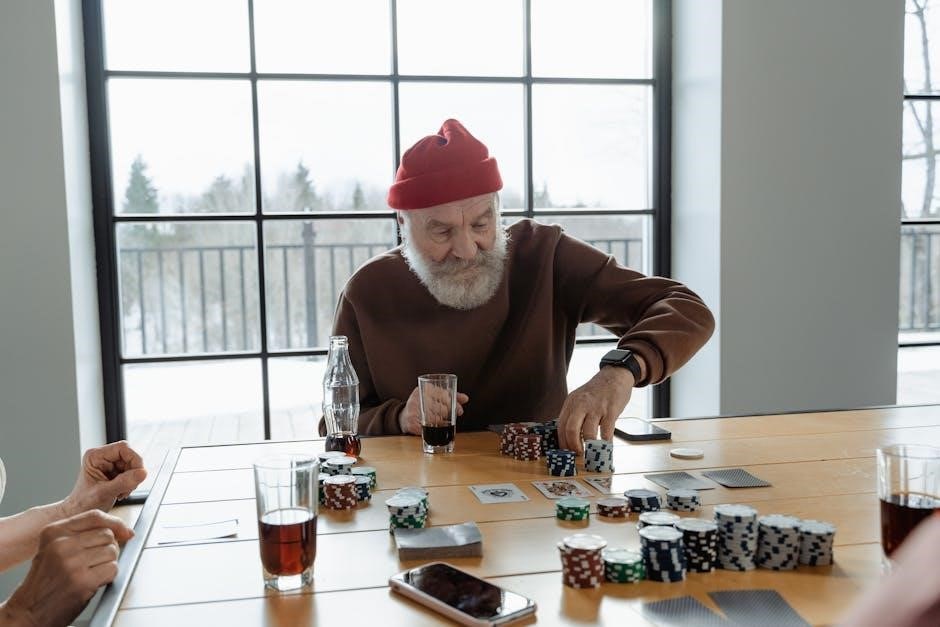Old Maid is a classic card game enjoyed by all ages, requiring simple strategy and luck. Players aim to avoid holding the unmatched Old Maid card at the end, ensuring quick, family-friendly fun.
Objective
The primary goal in Old Maid is to avoid being the player left holding the unmatched Old Maid card at the end of the game. This single card, typically a queen, has no pair and is set aside at the start. Players aim to discard all their cards by forming pairs, ensuring they do not end up with the Old Maid. The game concludes when all possible pairs have been matched, and the player holding the Old Maid is declared the loser. The objective is straightforward, making it accessible to all ages while offering a mix of luck and basic strategy. By carefully observing and remembering cards, players can increase their chances of avoiding the Old Maid, adding a layer of entertainment and challenge to this family-friendly game.
Brief History
Old Maid is a traditional card game with roots tracing back to the 19th century, originating in Europe. It gained popularity during the Victorian era and evolved into a family-friendly activity. The game is part of a category of “scapegoat” games, where one card is designated as the outcast. Initially, it was played with a standard deck, removing one queen to create the Old Maid card. Over time, specialized decks were developed, featuring unique designs and characters. The game’s simplicity and reliance on luck made it accessible to all ages, becoming a staple at social gatherings. Its appeal lies in its easy-to-understand rules and the light-hearted competition it fosters. Old Maid has also been known by other names, such as Schwarzer Peter in Germany, reflecting its cultural adaptability. Today, it remains a beloved card game, enjoyed for its nostalgic charm and straightforward gameplay.

History of Old Maid
Old Maid, a 19th-century European card game, evolved into a family-friendly activity, spreading across continents and adapting into various themed versions, reflecting its enduring popularity and cultural versatility.
Origins

Old Maid traces its origins to 19th-century Europe, emerging as a family-friendly card game. Inspired by earlier European games like Black Peter, it became popular in Victorian Britain. Initially a drinking game, it evolved into a kid-friendly activity, reflecting societal values. Its name symbolizes the Victorian era’s view of unmarried women, while continental versions like Black Peter reference historical figures. Historians suggest Asian influences, though its exact origins remain unclear. The game’s simplicity and pairing mechanics made it a global favorite, enjoyed across ages and cultures, adapting into themed versions while retaining its core charm. Its transition from adult entertainment to a children’s game highlights its versatility, ensuring its enduring appeal as a classic card game.
Evolution Over Time
Old Maid has evolved significantly since its 19th-century origins, adapting to cultural and societal changes. Initially a simple pairing game, it gained popularity as a family-friendly activity, moving away from its roots as a drinking game. Over time, new variations emerged, such as renaming the Old Maid card to themes like “Smelly Sock” or altering win conditions. The game spread globally, with versions like “Black Peter” in Europe and “Pekka-pelikortit” in Finland. Its versatility allowed it to remain relevant, with themed editions and creative rule tweaks. Today, Old Maid is enjoyed worldwide, maintaining its core mechanics while embracing modern twists. Its adaptability has ensured its enduring appeal, making it a beloved game across generations and cultures.

Cultural Significance
Old Maid holds a special place in gaming culture, transcending generations and borders. Originating in Victorian Britain, it reflects societal norms of the time, symbolizing the stigma of being unmarried. Its global popularity grew as it evolved into a family-friendly activity, becoming a staple in many households. The game’s simple yet engaging nature made it accessible to all ages, fostering bonding and laughter. Regional variations, like “Black Peter” in Germany and “Pekka-pelikortit” in Finland, highlight its adaptability to different cultures. Old Maid is more than just a game; it’s a reflection of societal values and a tool for bringing people together, making it a cherished part of cultural heritage worldwide.

Setting Up the Game
Old Maid is easy to prepare. Remove one queen as the Old Maid, shuffle the deck, and deal cards evenly. Players arrange their cards neatly, ready to begin.
Number of Players
Old Maid is a versatile game that can be enjoyed by 2 to 4 players, making it ideal for small gatherings. The game works best with multiples of two players, ensuring even distribution of cards. It’s a perfect activity for family game nights or casual get-togethers with friends. The simplicity of the game allows it to be accessible to all ages, from children to adults. With fewer players, the game moves quickly, while more players add excitement and unpredictability. The dynamic nature of Old Maid makes it adaptable to different group sizes, ensuring everyone can participate and have fun. This flexibility contributes to its enduring popularity as a classic card game.
Preparing the Deck
Preparing the deck for Old Maid is straightforward and ensures smooth gameplay. Start with a standard 52-card deck and remove one Queen, designating it as the Old Maid card. This single Queen remains aside, unused during the game, creating an unpaired card that players must avoid. Optionally, you can use a specialized Old Maid deck, which often includes unique illustrations and characters. If using a standard deck, shuffle thoroughly after removing the Queen to randomize the cards. This preparation step is crucial as it sets the foundation for the game’s objective: avoiding the unmatched Queen. The deck is then ready for dealing, ensuring each player receives an equal number of cards. Proper preparation ensures that the game begins fairly and that all players have an equal chance of avoiding the Old Maid card.
Shuffling and Dealing
Shuffling and dealing are essential steps to begin the Old Maid game fairly. Start by shuffling the prepared deck thoroughly to ensure the cards are well-mixed and random. Once shuffled, deal the cards evenly among all players. The number of players typically ranges from 2 to 4, and the deck should be divided equally, ensuring each player receives the same number of cards. Cards are dealt face-down to maintain secrecy. After dealing, each player should arrange their cards in their hand, facing toward themselves to hide them from others. This step ensures that no player has an unfair advantage and that the game starts with unpredictability. Proper shuffling and dealing are crucial for a fair and enjoyable game, allowing players to focus on strategy and luck as they aim to avoid the Old Maid card.
Arranging Cards
After dealing, players arrange their cards in their hand, ensuring they remain face-down to maintain secrecy. Each player carefully examines their cards to identify pairs, which are typically matched by rank or suit. Once pairs are found, they are placed face-up on the table. If a player has three cards of the same rank, only two can be paired, leaving one card unpaired. This step is crucial as it sets the foundation for the gameplay, allowing players to discard matched cards and focus on avoiding the Old Maid. Arranging cards strategically can also help players keep track of the remaining cards in play, potentially influencing their decisions during the game. Proper arrangement ensures clarity and fairness, making the game enjoyable for all participants.

Basic Rules of Play
Players take turns drawing cards from others’ hands, forming pairs by rank or suit. The goal is to discard all cards except the Old Maid, which designates the loser.
Pairing Cards
Pairing cards is central to Old Maid. Players must match cards of the same rank or suit to discard them. At the start, each player arranges their hand to identify pairs, laying them face-up immediately. During play, when a player draws a card that matches one in their hand, they place the pair on the table. This process continues until only one card remains—the Old Maid. The goal is to eliminate all your cards by pairing them, avoiding being the last player holding the unmatched Old Maid. Strategic pairing requires attention to the cards in play and careful decisions to avoid taking the lone card. Proper pairing ensures smooth gameplay and increases chances of winning, making it a key skill in mastering Old Maid.
Gameplay Mechanics
Old Maid’s gameplay revolves around turn-based card drawing and strategic pairing. Players take turns selecting a single card from another player’s hand, aiming to form pairs. Once a pair is created, it is immediately discarded face-up. The game progresses clockwise, with each player drawing a card from the hand of the player to their left. Players must carefully observe the cards in play to avoid picking the Old Maid. If a player draws the Old Maid, they must subtly integrate it into their hand without revealing its presence. The game ends when all pairs are discarded, leaving only the Old Maid. The player holding it is declared the loser. Proper shuffling and organization of cards are essential to maintain secrecy and ensure fair play, making the game both engaging and unpredictable for participants of all ages.
Ending the Game
The game concludes when all possible pairs have been discarded, leaving only the Old Maid card in play. The player holding this card at the end of the game is declared the loser. The conclusion is straightforward: once all players have paired and discarded their cards, the remaining unpaired card identifies the loser. The game ends abruptly, with no additional rounds or chances to redeem oneself. The player left with the Old Maid card must accept defeat, making the ending both clear and decisive. This sudden finish adds a layer of excitement and finality, ensuring the game remains engaging until the very last moment.
Determining the Loser

The loser of the game is the player left holding the Old Maid card when all other cards have been paired and discarded. As the game progresses, players aim to eliminate their cards by forming pairs, and the Old Maid card remains the only unpaired one. Once all possible pairs are discarded, the player who has the Old Maid card in their hand is automatically declared the loser. This can happen suddenly, as the game ends immediately when the Old Maid card is revealed. The loser is determined solely by possession of this card, making the outcome clear and definitive. Players must strategically avoid holding the Old Maid, adding an element of suspense and skill to the game. The loser’s identity is revealed conclusively, leaving no room for dispute or continuation.

Gameplay Mechanics
Players take turns drawing cards, pairing them, and passing cards to avoid holding the Old Maid. The game involves strategic card management and suspenseful card passing to evade the unmatched card.
Taking Turns
In Old Maid, play proceeds in a clockwise direction, with players taking turns drawing a card from another player’s hand. The dealer typically starts the game, offering their cards face down to the player on their left. Each player must carefully select one card from the offered hand, aiming to avoid the Old Maid. Once a card is drawn, the player examines it to see if it forms a pair with any card they already hold. If a pair is found, it is immediately discarded face up on the table. This process continues, with players taking turns until all possible pairs are exhausted. The game builds suspense as players strategically attempt to pass the Old Maid to others while avoiding it themselves. The loser is ultimately the one left holding the unmatched Old Maid card when all other cards have been paired and discarded.
Pairing During Play
During the game, players continuously look for opportunities to pair their cards. As soon as a player forms a pair, they must discard it immediately, placing the matched cards face up on the table. This ensures transparency and helps track the game’s progress. Pairing can occur in two ways: either by matching two identical cards (e.g., two kings or two fives) or by following specific rules if using a themed deck. When a player draws a card from another player’s hand, they must check if it forms a pair with any card they already hold. If it does, the pair is discarded right away. The goal is to eliminate all your cards by forming pairs, while strategically avoiding being left with the Old Maid. The game’s simplicity makes it easy for kids, yet its strategic elements keep adults engaged. Players must stay alert to pass the Old Maid without revealing its presence, adding a layer of fun and suspense to the gameplay.
Passing Cards
Passing cards is a central mechanic in Old Maid, adding unpredictability and excitement to the game; Players take turns offering their hand of cards to another player, who selects one card from the offered hand. This process continues in a clockwise or counterclockwise direction, depending on the group’s preference. The goal is to avoid being the player who ends up with the Old Maid card. As players pass cards, they must strategically decide which card to give without revealing its identity. This element of suspense makes the game engaging, as no one knows who might end up with the unwanted card. The passing mechanic ensures that the game remains dynamic and fun, requiring a mix of luck and strategic thinking to avoid being the loser. The simplicity of card passing makes it accessible to all ages while keeping the game lively and entertaining for everyone involved.

Strategies for Success
Observe opponents’ moves, remember card positions, and shuffle frequently to confuse others. Maintain a poker face to hide the Old Maid, blending skill and luck to avoid holding it.
Basic Tips for Kids

Teach children to stay attentive and organize their cards neatly. Encourage them to remember which cards have been played to avoid picking the Old Maid. Kids should keep their cards face down and take turns slowly. Emphasize the importance of keeping a straight face to hide excitement or nervousness. Simple strategies like matching cards by color or number can help them pair quickly. Encourage patience and remind them it’s okay to lose occasionally. Make the game fun by celebrating small victories and laughs. These tips help kids enjoy the game while learning basic card skills and social interaction through playful competition.
Advanced Tactics for Adults
For adults, mastering Old Maid involves strategic thinking and psychological play. Memorize the cards that have been discarded to track the remaining ones, increasing the chances of avoiding the Old Maid. Pay attention to opponents’ body language and card placement to anticipate their moves. Shuffle your cards occasionally to disguise the Old Maid among your hand, making it harder for others to identify it. Use misdirection by focusing on specific cards to distract opponents. Experienced players can also subtly influence the game by strategically passing cards they suspect contain the Old Maid. These advanced tactics add depth to the game, turning it into a fun yet competitive challenge for adults. Keeping a poker face is crucial to avoid giving away the Old Maid’s location, ensuring a thrilling experience for all players.
Psychological Aspects
The psychological elements of Old Maid make it a game of wit and deception. Players must master the art of misdirection to avoid suspicion when holding the Old Maid. Maintaining a neutral expression and avoiding revealing body language are crucial. Experienced players often bluff by shuffling their cards or focusing on specific cards to distract opponents. The game also relies on observation skills, as noticing others’ reactions can help identify who might hold the Old Maid. Additionally, the excitement of watching someone unknowingly pick the Old Maid adds a layer of amusement. These psychological tactics turn Old Maid into a game of not just luck but also mental strategy, making it engaging for players of all ages. The ability to deceive and observe creates a fun, competitive atmosphere that enhances the overall experience.
Variations and Creative Tweaks
Old Maid can be customized with unique decks, rule tweaks, or themed editions. Rename the Old Maid card, alter winning conditions, or introduce point systems for added fun and creativity.
Different Card Decks
Old Maid can be played with a variety of card decks, offering unique twists to the classic game. Traditional decks include 33 or 47 cards, while others use standard 52-card decks with one queen removed. Specialized Old Maid decks are designed specifically for the game, often featuring colorful illustrations and whimsical designs. Some decks replace the Old Maid card with themed characters, such as “Smelly Sock” or “Black Peter,” adding humor and creativity. Themed editions, like holiday or animal-themed decks, further enhance the gameplay experience. Using a dedicated Old Maid deck ensures a more immersive and visually appealing game, while standard decks provide flexibility for casual play. Regardless of the deck, the core objective remains the same: avoid being left with the unmatched card. This variety allows players to customize their experience, making Old Maid adaptable to different preferences and settings.
Rule Variations
While the core objective of Old Maid remains consistent, players can introduce creative rule variations to enhance gameplay. One popular variation involves designating multiple “Old Maid” cards, increasing the challenge and suspense. Another twist is allowing team-based play, where pairs of players work together to avoid holding the unmatched card. Some players prefer a point system, where successful pairing grants points, and the player with the most points wins. Additionally, rules can be adjusted to speed up the game, such as limiting the number of passes or setting a time limit. For advanced players, action cards can be introduced, forcing players to draw extra cards or skip turns. These variations keep the game fresh and adaptable to different skill levels and preferences, ensuring endless fun for both kids and adults. They offer flexibility while maintaining the game’s simple, enjoyable nature.
Themed Versions
Old Maid can be customized with themed decks to add variety and appeal to different interests. For instance, holiday-themed versions feature festive designs, while animal-themed decks showcase beloved creatures. Movie and cartoon character editions are popular among kids, making the game more engaging. Educational themes, such as historical figures or scientific concepts, can also be incorporated to blend learning with fun. Additionally, some decks introduce unique twists, like storylines or character-based gameplay, enhancing the experience. These themed versions retain the core mechanics of Old Maid while offering fresh aesthetics and themes, making the game versatile for various audiences. They allow players to enjoy the classic gameplay with a personalized touch, catering to individual preferences and adding excitement to traditional play.
Old Maid is a timeless, simple card game offering fun for all ages. Its easy rules and quick gameplay make it perfect for family gatherings or casual play. Encourage everyone to give it a try and enjoy the laughter and excitement it brings!
Final Thoughts
Encouragement to Play
Old Maid is a delightful and engaging card game that offers fun for players of all ages. Its simple rules and quick gameplay make it an excellent choice for family gatherings, parties, or casual get-togethers. Whether you’re introducing kids to card games or seeking a lighthearted activity with friends, Old Maid delivers endless enjoyment. The game’s portability and minimal setup requirements allow you to play anywhere, anytime. Its focus on matching and strategy ensures that both children and adults can participate, making it a great way to bond and create lasting memories. With its timeless appeal and versatility, Old Maid is a perfect addition to your game collection. So gather some friends, shuffle the deck, and experience the joy of avoiding the Old Maid card firsthand!



